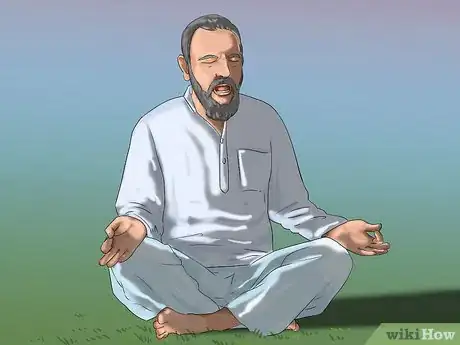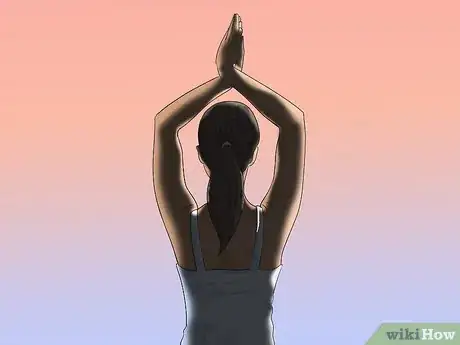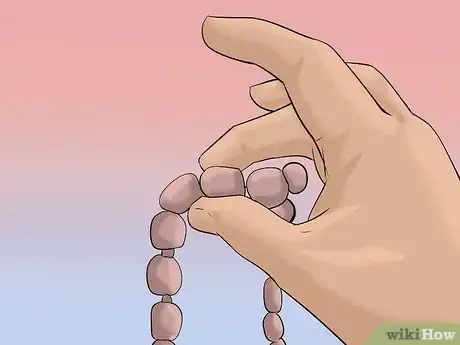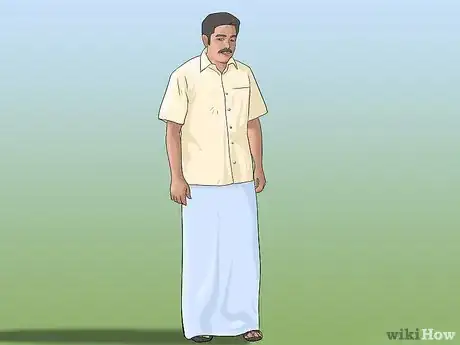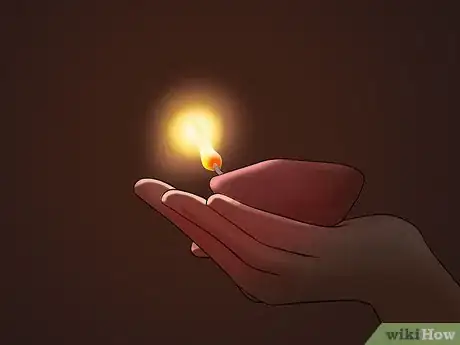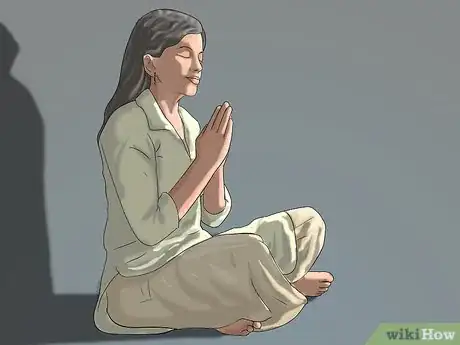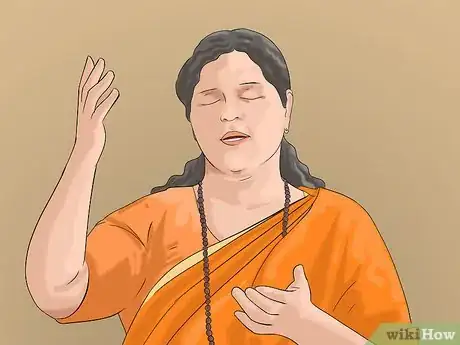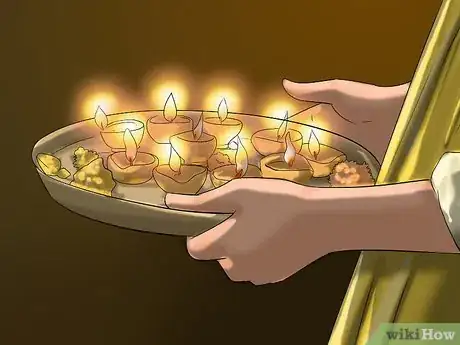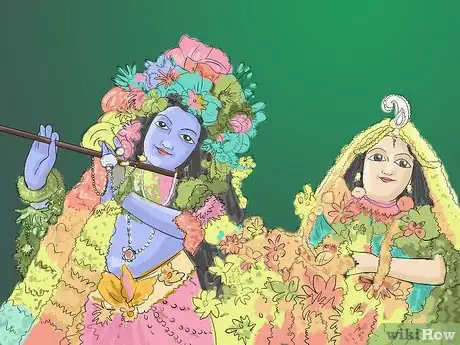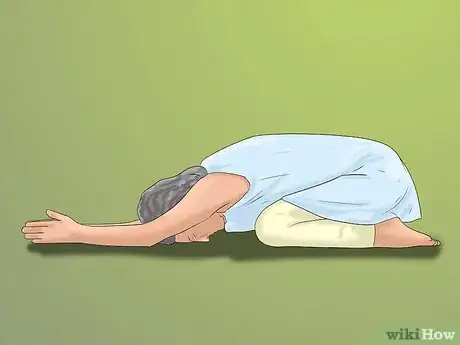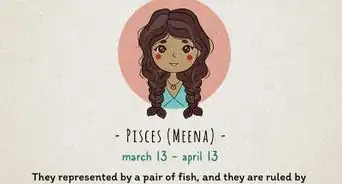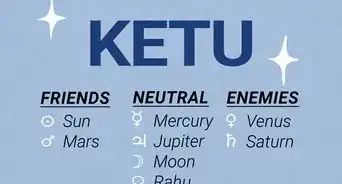wikiHow is a “wiki,” similar to Wikipedia, which means that many of our articles are co-written by multiple authors. To create this article, 21 people, some anonymous, worked to edit and improve it over time.
This article has been viewed 124,853 times.
Learn more...
Sound is power and different sounds have different effects on the human psyche. If a soft sound of wind rustling through leaves soothes our nerves, the musical note of running stream enchants our heart, thunders may cause awe and fear. The sacred utterances or chanting of Sanskrit Mantras provide us with the power to attain our goals and lift ourselves from the ordinary to the higher level of consciousness. They give us the power to cure diseases; ward off evils; gain wealth; acquire supernatural powers; worship a deity for exalted communion and for attaining blissful state and attain liberation.
Steps
Background to Hindu prayer
-
1Learn about the origin of Mantras. Mantras are Vedic in origin. The teachings of the Vedas consist of various Mantric chants or hymns recognized by different seers or Rishis from the Cosmic Mind. Since the Vedas are impersonal and eternal, the exact historical date of the origin of Mantra chanting is hard to arrive at. For example, every Mantra in the Vedas, Upanishads and various religious traditions (sampradayas) within Hindu religion begin with Om or Aum - the primordial sound, the sound that is said to have its origins at the time of the creation of the cosmos - also referred to as the 'Big Bang'.
- "Mananaat traayate iti mantrah" (That which uplifts by constant repetition is a Mantra.)
-
2Understand the Om. The Beginning & the End. The Bible (John 1:1) says: "In the beginning was the Word and the Word was with God and the Word was God." Modern Vedic philosophers have interpreted this teaching of the Bible, and equated Om with God. Om is the most important of all mantras. All mantras generally begin and often also end with Om.[1]Advertisement
-
3Learn about healing by Mantropathy. The chanting of Om has now received widespread recognition. Mantras can be used to treat tension and many other difficult diseases that are yet to come.
-
4Chant. There are many schools of thought on the methods of chanting. A Mantra chanted correctly or incorrectly, knowingly or unknowingly, carefully or carelessly, is sure to bear the desired result for physical and mental well being. It is also believed by many that the glory of Mantra chanting cannot be established through reasoning and intellect. It can be experienced or realized only through devotion, faith and constant repetition of the Mantra.
- According to some scholars, Mantra chanting is Mantra Yoga. The simple yet powerful Mantra, Om or Aum harmonizes the physical forces with the emotional forces with the intellectual forces. When this happens, you begin to feel like a complete being - mentally and physically. But this process is very slow and requires a lot of patience and unfailing faith.
Performing Hindu prayers
-
1Take a bath to cleanse yourself.[2]
-
2Dress in lightly coloured clothing.
-
3Light a diya (lamp) while chanting the prayer for it.[3]
-
4Chant your opening prayers.
-
5Chant the mantras prayers and bhajans you wish to.
-
6Perform Aarti by moving the thali (plate) with the diya in a circular motion.[4]
-
7Place flowers at the murtis.[5]
-
8Chant closing prayers.
Community Q&A
-
QuestionCan I use prayer for talking about anything to the Gods?
 Community AnswerYes! The Gods are your friends, and will listen to any problem or wish you may have.
Community AnswerYes! The Gods are your friends, and will listen to any problem or wish you may have. -
QuestionI've got many problems in life: work, love, family, home. I want to pray. Can you help me?
 Shubham kumarCommunity AnswerIf you pray, luck will be at your side, but you still have to work hard to get whatever you want and never give up. God sometimes tests your devotion by giving you pain; fight it.
Shubham kumarCommunity AnswerIf you pray, luck will be at your side, but you still have to work hard to get whatever you want and never give up. God sometimes tests your devotion by giving you pain; fight it. -
QuestionWhere is it best to pray?
 Community AnswerThere is no best place for praying. God is everywhere. But according to Hindu beliefs, the temple is the best place for praying.
Community AnswerThere is no best place for praying. God is everywhere. But according to Hindu beliefs, the temple is the best place for praying.
References
- ↑ https://www.huffpost.com/entry/meaning-of-om_b_4177447
- ↑ https://www.hindujagruti.org/hinduism/daily-puja-vidhi
- ↑ https://rgyan.com/blogs/30-rules-needed-to-be-followed-for-worship/
- ↑ http://londonmandir.baps.org/worship/arti-the-hindu-ceremony-of-light/
- ↑ https://rgyan.com/blogs/30-rules-needed-to-be-followed-for-worship/

